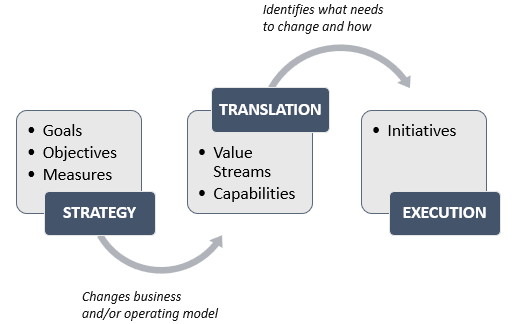Closing the Gap: Connecting Strategy to Execution
Share Now:
Many formulated strategies do not materialize. Frequently, they disintegrate during execution, regardless of how well they are defined. Digital strategies are no exception. According to Forbes, 84% of digital transformations do not deliver an expected return on investment. This results in wasted resources and missed opportunities, a trend reflected in many studies, including those from Forbes.
If most organizations struggle to realize their digital strategies successfully, why continue investing resources? The answer is clear: in today’s digital economy, organizations must keep investing or risk becoming obsolete. Digital transformations are becoming increasingly complex and costly, making effective resource utilization during execution more critical than ever.
While there are many reasons for the failure of strategy execution, the fundamental issue often lies in a lack of transformation capability. Specifically, organizations must be able to effectively translate strategies into actionable steps. This discussion will focus on this critical aspect of transformation capability.

Ned Aleksic
Chief Strategic Consultant
The Missing Middle
Strategies are often directly broken down into a series of initiatives (see Figure 1). However, these individual initiatives, derived from the overarching strategy, often lack cohesion and can become misaligned. Creating strategic roadmaps can be challenging due to the difficulty of properly sequencing these misaligned initiatives, which may have redundant or missing work items and overlook crucial dependencies. As a result, strategies can become non-actionable.

Established businesses have existing business and operating models that must be adapted to implement the strategy effectively. Without a thorough assessment of how the strategy impacts these models, initiatives derived directly from the strategy may focus on the wrong priorities, potentially undermining the entire strategy’s effectiveness. This underscores the critical gap between strategy and execution. In simple terms, the approach illustrated in Figure 1 lacks an essential part—the middle. This missing middle serves as the bridge needed to close the gap between strategy and execution.
Strategy Translation
To make a strategy actionable, it is essential to “translate” it into a cohesive set of initiatives. This involves assessing the strategy’s impact on the business and operating models. Business Architecture techniques are particularly effective for this translation process. The concepts of Value Streams and Business Capabilities serve as high-level abstractions to evaluate how a business creates, delivers, and captures value through its people, processes, information, and technologies.

During the Translation stage (see Figure 2), the impacts of the strategy on value streams and capabilities are analyzed to find gaps and necessary changes. These changes are harmonized and mapped to a series of aligned initiatives that collectively support the realization of the strategy. A well-crafted strategic roadmap will optimize strategy execution, eliminating redundant activities and ensuring that dependencies are accounted for. This approach ultimately makes the strategy actionable.
Conclusion
To enhance strategy execution and increase the likelihood of success, organizations must improve their transformation capability. A strategy becomes actionable when it is translated into a cohesive set of initiatives. This translation involves using business architecture techniques to assess the strategy’s impact on business and operating models, as well as finding which elements of these models need to change and how.


